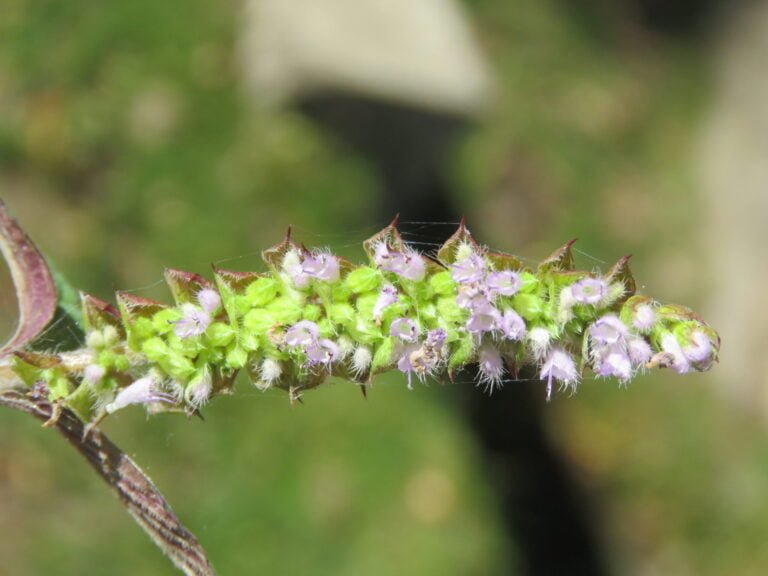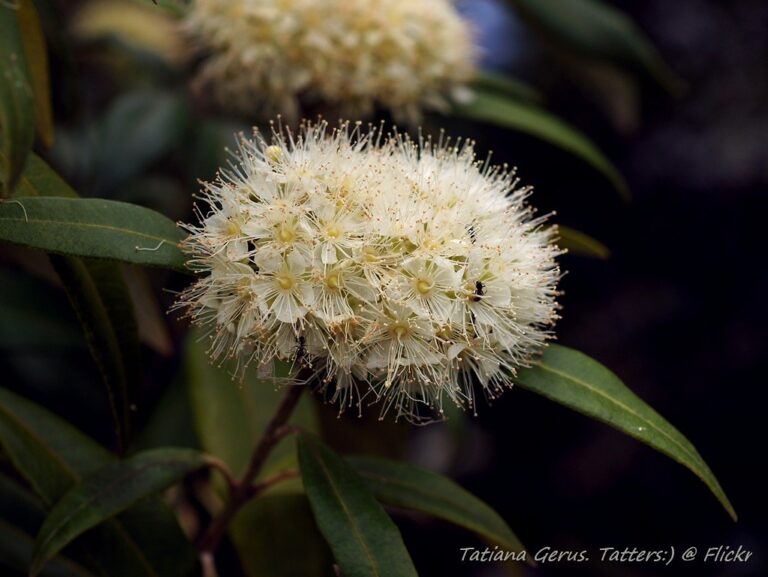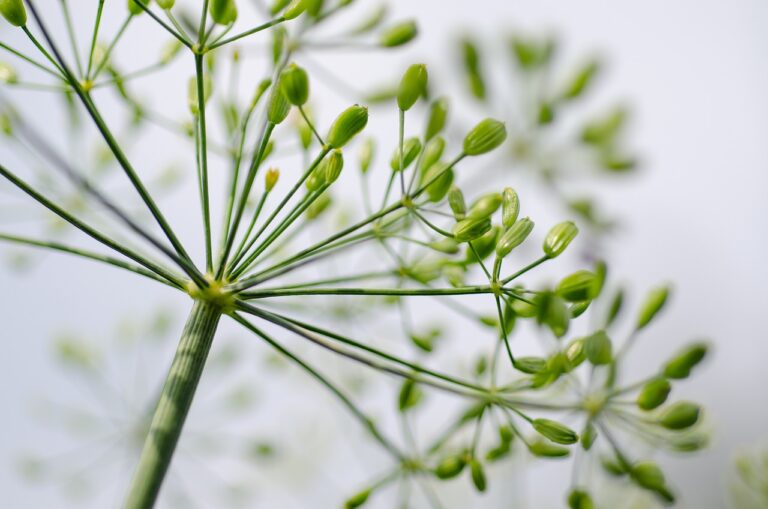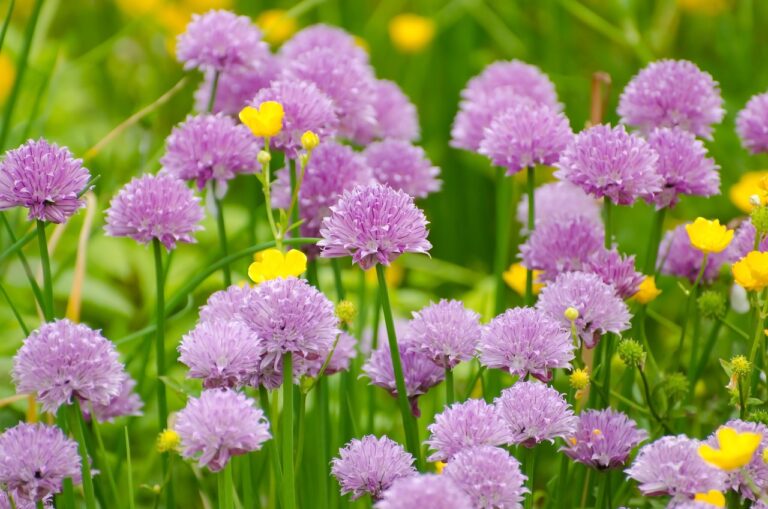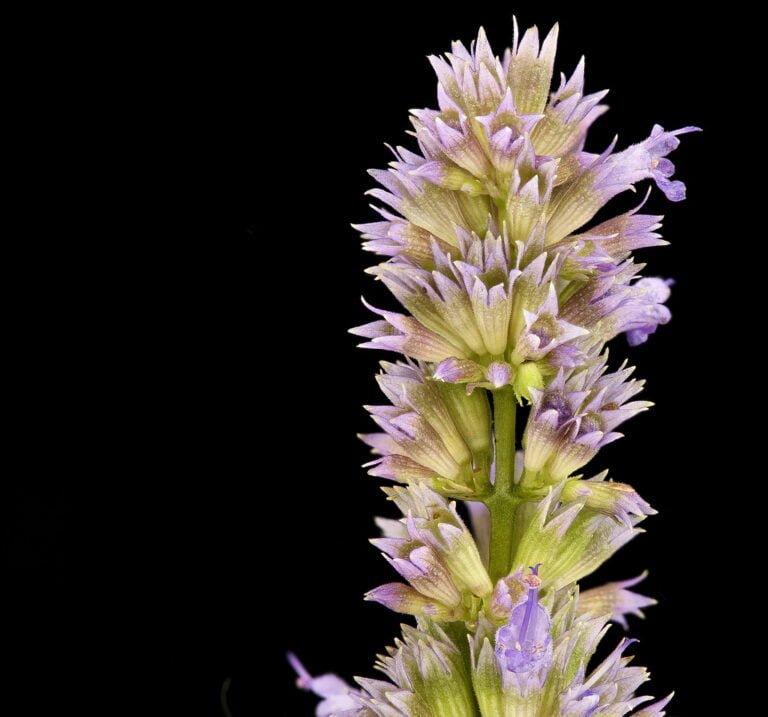Basil
Oh, basil, my culinary essential! With linalool, eugenol, and more, it’s a powerhouse herb. Use Thai basil for an exotic twist or lemon basil for citrusy delights. From the mint family, basil boasts anti-inflammatory and antimicrobial properties. Find it thriving in sunny spots with well-drained soil. Plus, it’s loaded with vitamins and minerals. Cook up pesto, garnish pasta, or infuse oils with its aromatic goodness. There’s so much to learn about basil’s uses, health benefits, and growth secrets, so welcome its versatility and flavors in your dishes!
Phytochemistry
In exploring the phytochemistry of basil, we unveil a fascinating array of volatile compounds that not only contribute to its distinct aroma but also hold significant medicinal and therapeutic potential. Basil’s phytochemical composition is rich and diverse, with compounds like linalool, methyl chavicol, eugenol, 1,8-cineole, and myrcene playing vital roles in its aromatic properties and health benefits.
Among these compounds, essential oils like eugenol stand out for their insecticidal properties, making basil a natural and effective option for pest control. Studies have highlighted basil’s effectiveness not only as an insecticide but also as an insect repellent, showcasing its multifaceted uses in pest management. Moreover, the presence of these volatile compounds contributes to basil’s ability to inhibit bacterial and fungal growth, underscoring its potential as a natural antimicrobial agent.
The medicinal properties of basil are also closely tied to its phytochemistry. The interplay of these volatile compounds gives basil its anti-inflammatory, antioxidant, and antimicrobial characteristics, making it a valuable herb for promoting overall well-being. By understanding the intricate phytochemical composition of basil, we can fully appreciate the holistic benefits it offers beyond its culinary uses.
Similar Species
Exploring the diverse basil varieties like Thai basil and lemon basil opens up a world of culinary possibilities, allowing for the creation of dishes that tantalize the taste buds and boost the dining experience. The herb, belonging to the Family Lamiaceae, offers a spectrum of choices beyond the traditional sweet basil. Thai basil, with its anise undertones, adds a unique twist to Asian dishes, while lemon basil enlivens up salads and desserts with its citrusy notes.
Thai basil, scientifically known as Ocimum basilicum var. thyrsiflora, boasts dark green leaves and a spicy, licorice flavor that sets it apart from its more common sweet counterpart. Its aromatic essence enriches stir-fries, curries, and noodle dishes, providing a burst of freshness.
On the other hand, lemon basil, or Ocimum americanum, stands out with its zesty lemon fragrance and flavor profile. The herb’s delicate leaves add a revitalizing touch to beverages, fruit salads, and seafood dishes. Its versatility in both sweet and savory recipes makes it a must-have for culinary enthusiasts looking to experiment with new flavors.
Investigating the varied world of basil varieties reveals a lush tapestry of flavors and scents that cater to a wide range of culinary preferences.
Taxonomy
Basil’s classification is a captivating domain where we uncover the complex categorization of this adaptable herb. Understanding the plant classification fundamentals sheds light on its scientific naming conventions, guiding us through the evolutionary relationships within the Ocimum genus. Delving into basil’s taxonomy allows us to appreciate the diversity and interconnectedness of these aromatic plants.
Plant Classification Basics
Within the domain of plant taxonomy, grasping the basic principles of classification offers a sturdy groundwork for exploring the complex relationships among different botanical species. Basil, specifically Ocimum basilicum, belongs to the mint family. Its taxonomy is intricate due to the vast array of cultivars and hybridizations, resulting in variations in leaf characteristics and scents. The essential oils found in basil, such as linalool and eugenol, contribute to its aromatic properties and medicinal uses in herbal medicine. Understanding the classification of plants like basil not only sheds light on their genetic diversity but also highlights their significance in culinary traditions and cultural practices globally. The Ocimum genus exemplifies the rich botanical heritage within the basil family, showcasing its adaptability and importance in various fields.
Scientific Naming Conventions
Scientific naming conventions, essential for understanding plant taxonomy, provide a structured framework for categorizing and identifying botanical species like basil within the Ocimum genus. Basil, scientifically known as Ocimum basilicum, belongs to the Lamiaceae family, commonly referred to as the mint family. The taxonomy of basil plays an important role in distinguishing the various varieties and understanding their genetic relationships. By recognizing the scientific naming conventions of basil, we gain valuable insights into its evolutionary history and connections with other plant species. The intricate details embedded in the nomenclature of basil aid in unraveling the diversity and characteristics present within the Ocimum genus, highlighting the importance of taxonomy in botanical studies.
Evolutionary Relationships in Basil
Exploring the evolutionary relationships of basil reveals a compelling journey through its genetic composition and morphological characteristics. Within the Ocimum genus, the sweet basil, scientifically known as Ocimum basilicum, stands out as a prominent species. The taxonomy of basil is complex due to the diverse cultivars and hybridizations present, making it a subject of interest for botanists. By studying basil’s genetic makeup and evolutionary history, researchers gain insights into its diverse variations and adaptations within the plant kingdom. Understanding the taxonomy of basil not only aids in categorizing its different forms but also illuminates the intricate web of relationships between various basil species. This knowledge is essential for conservation efforts and for further exploring the potential benefits that basil varieties may offer.
Cultivars
When discovering the realm of basil, exploring the different assortment of cultivars reveals a realm of enticing flavors and aromatic possibilities. Genovese basil, with its robust, sugary taste, is a fundamental ingredient in Italian meals, making it a necessity for any culinary herb garden. Its fragrant scent and large, deep green leaves are ideal for pesto or caprese salad.
Lemon basil, on the other hand, provides a tangy, citrusy hint that livens up salads, seafood, and desserts. The invigorating twist it brings to dishes is a pleasant surprise for the palate. Thai basil brings a anise-like essence to Asian cuisine, boosting stir-fries, curries, and noodle dishes with its distinct flavor profile.
For those seeking to add a burst of color to their dishes, Purple Ruffles basil is a showstopper. Its dark purple, frilled leaves not only look striking as a garnish but also offer a gentle, sweet taste that complements a variety of dishes. These varied basil cultivars cater to a range of culinary preferences, providing endless possibilities for experimenting in the kitchen. Cultivating these herbs at home guarantees a fresh and fragrant supply for enhancing your cooking to new heights.
Distribution and Habitat
Native to India and tropical regions, basil has spread globally due to its culinary and medicinal significance. This herb, scientifically known as Ocimum basilicum, has found its way into kitchens and gardens worldwide. Basil thrives in hot and dry conditions, making it a perfect fit for regions with warm climates. It is sensitive to cold temperatures and will not survive frost, behaving as an annual in colder areas.
Basil plants are commonly grown for their aromatic leaves, which vary in flavor from sweet to spicy. Cultivars like Genovese, Purple Ruffles, and Lemon basil offer unique tastes and scents, adding depth to dishes. The distinct scent of basil comes from its volatile compounds such as linalool, methyl chavicol, and eugenol, making it a favorite herb for culinary creations.
Health benefits associated with basil include its antimicrobial and anti-inflammatory properties. It is also a good source of vitamins A, K, and C, as well as minerals like magnesium and iron. Growing basil is relatively easy, whether in pots on a sunny windowsill or in the garden alongside other herbs like mint. Its versatility and rich history make basil a beloved addition to any garden or kitchen.
Cultivation
I’m excited to share some essential tips for cultivating basil successfully. To start, basil thrives in well-draining soil with at least 6-8 hours of sunlight daily, so choose a sunny spot in your garden or use a container on a sunny balcony. Remember to water your basil consistently, ensuring the soil stays moist but not waterlogged, and don’t forget to prune regularly to encourage bushier growth and prevent flowering, which can affect flavor.
Soil and Sunlight
For thriving basil plants, make sure they are planted in well-draining soil with a pH level between 6.0 to 7.5 and receive at least 6-8 hours of full sunlight daily for best growth. Prime growth of basil is achieved in sandy loam or loamy soil types. Insufficient sunlight can result in leggy and weak basil plants, so it’s essential to provide the required sunlight exposure. Proper soil moisture is also crucial for the health of basil plants, as they prefer soil that is neither too dry nor waterlogged. By ensuring the right soil conditions and ample sunlight, you can cultivate vibrant and flavorful basil plants that will flourish in your garden.
Watering and Pruning
Ensuring appropriate watering and pruning practices is essential for cultivating healthy and flavorful basil plants in your garden. To grow robust basil plants, water regularly, aiming for consistently moist soil without overwatering. Remember to water at the base of the plant to prevent fungal diseases and maintain dry leaves. Pruning basil is equally vital – pinch off the tips frequently to encourage bushier growth and deter flowering. Removing yellowing or damaged leaves will improve the overall health and vigor of your basil. Proper pruning also guarantees a continuous harvest of fresh leaves, enhancing the flavor of your dishes. By mastering these techniques, you’ll nurture thriving basil plants that will enhance your culinary creations.
Uses
When exploring the marvelous world of basil, one cannot overlook its versatile and delightful uses in the culinary domain. Basil, with its distinctive flavor and fragrance, is a staple herb in many kitchens. One of its most renowned applications is in Italian pesto, a delicious sauce crafted from basil, garlic, pine nuts, Parmesan cheese, and olive oil. The combination of these ingredients creates a rich and aromatic blend that enriches pasta, sandwiches, and more.
For home gardeners, basil is a must-have in herb plants collection due to its ease of growth and maintenance. This herb thrives in warm, sunny conditions, making it a favorite choice for those seeking to cultivate fresh ingredients. Harvesting basil at the peak of its growth guarantees top-notch flavor and aroma. By picking the leaves before the onset of cold weather, you can savor the best taste from your basil plant.
Whether you are a seasoned chef or a novice cook, the uses of basil are endless. From adding a sprinkle of fresh basil to enhance a dish’s flavor to creating a vibrant pesto sauce, this herb offers a world of culinary possibilities. Embrace the versatility of basil and let its delightful essence enrich your culinary creations.

